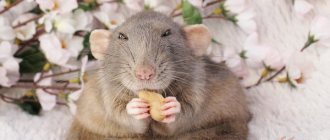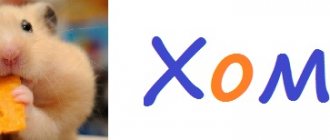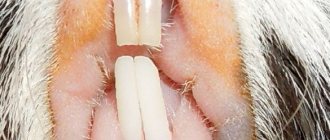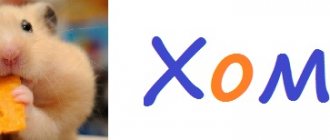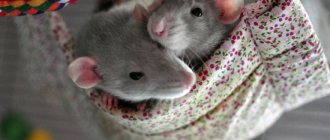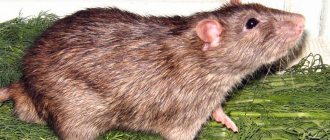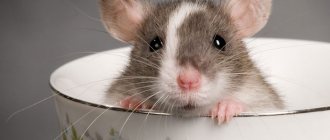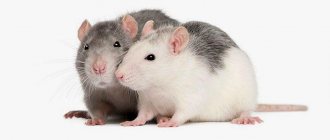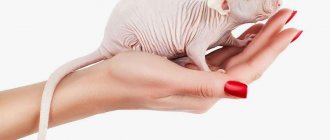The structure of rat teeth
The decorative rat has 16 teeth - 4 incisors and 12 molars. They are composed of three layers: pulp, dentin and enamel. Enamel is the hardest coating, it looks like a crown. Next comes a layer called dentin. Its thickness is greater than the other two layers combined. It is softer than enamel. Both layers provide reliable protection for the soft pulp, in which blood vessels and nerve canals are located.
The point of attachment with the jaw bone and gum is called the periodontium. It serves as a reliable connection with the near incisors, molars and alveoli. Molars are molars located in the back of a rat's jaw (three on the jaws behind the incisors). The incisors are the sharpest front teeth that grow throughout the rat's life.
Mineral composition of teeth of decorative rats
The main component of the enamel and dentin of rodent teeth is calcium, so it must be regularly included in the animal’s diet. To improve the metabolism of calcium and phosphorus, it is necessary to add fish oil, calcium gluconate, and calcium chloride to the rodent’s feed.
Important! If rats' incisors are not ground down on hard materials, they will grow in a spiral pattern.
Mineral composition
A rat's teeth are made up of three layers:
- pulp;
- dentin;
- enamel.
Pulp is the soft core. This is a concentration of nerve canals and blood vessels. The pulp is surrounded by a harder layer of dentin. Its thickness exceeds the layers of pulp and enamel combined.
The outer coating – enamel – is the hardest and most durable. The enamel crown contains mineral components, the main one being calcium.
Features of incisors
The cubs' incisors erupt 1 - 1.5 weeks after birth. A rat's teeth grow very quickly, up to two to three millimeters per week. They grow to normal size after two months, but do not stop growing. This feature is due to the fact that rats chatter their teeth. To avoid breaking, cracking, or dulling, they must be ground off in time.
If the animal does not have the opportunity to do this with the help of a special material, the rodent begins to chatter its teeth. Otherwise, the incisors will begin to bend into a spiral and bend at an angle of eighty degrees. In the wild, this can cause discomfort to the animal, cause hunger, or even lead to the death of the animal. The same applies to individuals with malocclusion. Because of this, they are unable to grind down the lower edge of the enamel correctly.
Rat anatomy: location of internal organs
Since, as we have already said, rats belong to the category of mammals, the arrangement of their organs is not much different from their relatives in biological species. In the picture below you can see all the organs in cross-section:
1 - aorta; 2 - heart; 3 - light; 4 - diaphragm; 5 - spleen; 6 - ovary; 7 - kidney; 8 - oviduct; 9 - bladder; 10 - cecum; 11 - pancreas; 12 - stomach; 13 - liver.
And here is a detailed diagram of the circulatory system of a rat:
1 - atria; 2 - ventricles; 3 - left aortic arch; 4 - innominate artery; 5 - left subclavian artery; 6 - right subclavian artery; 7 - carotid arteries; 8 - dorsal aorta; 9 - splanchnic artery; 10 - anterior mesenteric artery; 11 - renal artery; 12 - posterior mesenteric artery; 13 - genital artery; 14 - iliac artery; 15 - caudal artery; 16 - anterior vena cava; 17 - jugular veins; 18 - subclavian veins; 19 - tail vein; 20 - iliac vein; 21 - mesenteric vein; 22 - portal system of the liver; 23 - hepatic vein; 24 - posterior vena cava; 25 - pulmonary artery; 26 - pulmonary vein; 27 - azygos vein.
And we will dwell on the interesting features of their physiology.
For example, did you know that these animals have a navel, but do not have a gallbladder or tonsils? And at the beginning of the large intestine there is an appendix, which an inexperienced veterinarian can easily confuse with a benign tumor: it is so large and unusual in its structure.
Another interesting fact: these animals have poor eyesight. The rat sees space at an angle of only 16°, and it sees the world around it in gray tones. If she can still distinguish between blue and green shades, then for her the red color is darkness. Surprising, wouldn't you agree?
But poor eyesight is compensated by an excellent sense of smell and touch: mainly with their help they perceive everything around them.
The structure of molars
Molars are wide and flat in shape. Interestingly, rats do not chew, but grind food using molars. When an animal eats, its jaws do not move up and down, but back and forth. Moreover, only one of the jaws moves. Thus, the food does not crumble, but is ground, after which the animal swallows it.
For better grinding of food, ridges and tubercles are provided on the molars. Enamel covers only the sides of the molars - the middle has a dentin coating. It is worth noting that the enamel is very durable - its hardness coefficient is 5.5 (for comparison, for diamond it is 10).
Molars in baby rats erupt alternately from near to far:
- on the 19th day of birth - the first two pairs;
- on the 21st day - the second batch;
- by 4–5 weeks – the third ones complete the dentition.
A six-week-old rodent already has a full set of teeth. Molars grow until the animal is 4 months old, then growth gradually stops.
Structure of incisors
These are symmetrically located rat teeth that help to bite, gnaw, and tear food and all obstacles that come in the way.
Their growth begins in rat pups 7–9 days after birth, and by 8 weeks they reach their normal size. In adult individuals, the incisors grow constantly and quickly; they increase by 2–3 mm per week and have no roots. That is why they require constant grinding. Then they do not break off, do not become dull, and become sharp.
Pets use special bars and solid food for this purpose.
Interesting! The incisors of rats are covered with enamel only in front; the pulp is protected by dentin at the back. During stitching, the back wears off faster than the front. That's why they are so sharp.
Posts 1 page 18 of 18
Share12011-03-02 20:22:48
- Author: runa
- Administrator
- From: Donetsk
- Registered: 2009-08-15
- Invitations: 0
- Messages: 20600
- Female gender
- Time spent on the forum: 6 months 7 days
- Last seen: Yesterday 11:44:35
topic for discussion of various rat dental problems
Share22011-03-02 20:23:37
- Author: runa
- Administrator
- From: Donetsk
- Registered: 2009-08-15
- Invitations: 0
- Messages: 20600
- Female gender
- Time spent on the forum: 6 months 7 days
- Last seen: Yesterday 11:44:35
if your teeth grow too much and your gums are damaged:
from Lady-bird: First, deal with the teeth. They are very easy to trim. I prune while standing. I place the rat on top of me in the chest area, lean back so that the rat does not fall, and secure it by the neck and head. The left hand opens the mouth, the right hand cuts the teeth. In principle, rats endure this procedure stoically, not the first time, of course, but you can come to an agreement with them. The tooth is cut in several stages. It's better to undercut than to overcut. A neglected tooth may have a rather long pulp; therefore, it is more likely to reach the vessel if you try to immediately equalize the length of both teeth. The rat is not afraid of cutting its teeth, but of a metal tool in its mouth and the clicking sound when cutting. The rat is not in pain - she is rather scared. The second is to treat the wound made by the overgrown tooth. Use a cotton swab to remove pus and add chlorhexidine. If the location of the wound allows, fill it with aluminum spray or pediripra. It’s better not to spray it in your mouth, but apply it thickly from a container onto a cotton swab so that it bubbles, and then put it in your mouth. You will probably have to trim your teeth for the rest of your life.
from o-netzumi: I saw this at the veterinarian, and have been doing it myself ever since. My husband and I do this together.
We turn the rat onto its back, the husband holds its head and front paws. I insert a thick knitting needle between his jaws, the rat automatically opens the mitten, at which time I quickly and carefully bite off one of his incisors with forceps. On the side. Then the same procedure on the other side. Takes seconds once you get the hang of it.
Share32011-03-02 20:26:37
- Author: runa
- Administrator
- From: Donetsk
- Registered: 2009-08-15
- Invitations: 0
- Messages: 20600
- Female gender
- Time spent on the forum: 6 months 7 days
- Last seen: Yesterday 11:44:35
I am writing after the end of this strange story. On Saturday the 26th at 13.20 I noticed that Chara was persistently crawling into the corner of the cage and was behaving somehow strangely. I put her in the carrier, after about five minutes I noticed droplets of liquid in the carrier, an examination showed that saliva was flowing from Chara’s mouth. at the same time, the animal does not suffocate, but its paws do not obey it well, some curvature of the muzzle has appeared (to the right). In 10 minutes the animal cannot be recognized. I had many different options for why this could happen, but I couldn’t single out one. To be sure, I dialed Silver Silens: they decided to immediately inject the hormone and furosemide. A.A. that day I worked from 15.00. At three I was already with her. By this time, Chara already looked more cheerful and was not drooling. An examination showed that there was a problem with the teeth. And to be sure, you need to do an x-ray. They prescribed ab, painkillers and disinfection of the oral cavity with Metrogyl. On Saturday, Chara lived in a quarantine cage on soft food, because... I didn’t eat hard food. On Sunday, already in the morning, she was rushing around the cage, gnawing on the dryer and generally indignant at the confinement of the dominant in this closet. She moved into a common cage. Yesterday we took an x-ray, the picture showed that the problem really was with the teeth, the so-called molars. Perhaps part of the tooth broke off and food got stuck in the crack and rotted... For now I continue the course of ab and metrogil.
Share42011-03-02 20:27:41
- Author: Iva
- Participant
- From: Dnepropetrovsk
- Registered: 2010-10-14
- Invitations: 0
- Posts: 4272
- Female gender
- Age: 40 [1981-05-29]
- Spent on the forum: 1 month 6 days
- Last visit: 2017-04-19 13:49:59
Skeleton
Despite its lightness, the skeleton is strong, mobile and elastic.
The skull and its facial part are elongated; the joints of the bones are well developed on the skull. It contains paired coronoid, frontal, parietotemporal, lamboid, interparietal bones and unpaired occipital bones.
The lower jaw can move in three directions: across, along and up.
Like all mammals, the mouse spine is divided into five sections and includes:
- cervical – 7 vertebrae,
- thoracic – 13 vertebrae,
- lumbar – 7 vertebrae,
- sacral – 4 vertebrae, two of which are fused,
- caudal - the number of vertebrae can reach 20.
The sternum is narrow and consists of 13 paired ribs. Some species of mice do not have collarbones, which gives them the ability to crawl through tiny holes.
Malocclusion and occlusion in rodents
Occlusion is the exact alignment of the upper and lower rows of teeth when chewing food. A slight displacement to the side is enough and the grinding of the surfaces will occur unevenly, the growth of the teeth will be excessive, and one incisor (or molar) may be smaller than the neighboring one. The appearance of sharp edges, shoots, and fragments is dangerous for the pet; they injure surrounding tissues, causing inflammation and suppuration.
Malocclusion is a disease that is characterized by improper formation of the dentition due to poor wear of teeth and the formation of pathological surfaces. Actually, malocclusion is the process of improper grinding of dental surfaces; at first glance, it is not dangerous, but as a result it can lead to the following problems in the oral cavity in rodents:
- wounds, ulcers on the oral mucosa;
- changes in tooth root growth;
- infection of periarticular tissues and organs. Bacterial microflora and purulent foci can spread to bone tissue, conjunctival sac, and postorbital space. As a result, abscesses, conjunctivitis, and osteomyelitis develop;
- deformation of the temporomandibular joint.
Any discomfort in a rodent's mouth does not allow it to eat normally, and apathy, exhaustion, dehydration, and disruption of the gastrointestinal tract develop. With purulent processes, there is a threat of blood poisoning (sepsis) and the development of secondary pathological processes, such as rhinitis, dermatitis, pododermatitis, etc.
Important! A veterinarian-ratologist, having identified the root cause of diseases that have developed in a rodent, makes a diagnosis and summarizes it with one name: “dental syndrome”.
How is filing of front teeth performed?
The technique of filing teeth varies depending on the condition of the oral cavity, the current diagnosis and treatment goals. Teeth filing begins with a detailed diagnosis. The specialist evaluates the feasibility of the procedure and identifies the teeth that need correction. For an accurate diagnosis, an examination is carried out, the causes of the disease are studied, and a treatment method is determined. The procedure consists of simple steps:
- Determination of the working area. For this, wax plates or special aerosols are used. The use of additional means allows you to mechanically highlight or paint an area that stands out from the general row and prevents the normal closure of teeth. In particularly advanced situations, it will be necessary to create a plaster model of the client’s jaw;
- Anesthesia if a large layer of hard tissue is to be removed;
- Direct filing with a diamond bur. On chewing teeth, the enamel is removed in the areas of protruding cusps. In the case of incisor processing, multidirectional movements are used to create the correct tooth shape;
- Grinding the surface, using products to replenish the deficiency of enamel minerals, as well as drugs to reduce sensitivity and strengthen dental tissue.
After filing, the thickness of the enamel changes, so sensitivity often increases. This phenomenon is temporary and for some time after treatment it is better to refrain from eating too hot or cold food. If the problem does not go away, it is better to consult a dentist.
Dental problems in pet rats
Rats make great pets. They are very smart and clean animals. They belong to the rodent family, so their main advantage is their incisors. Rat owners quite often encounter problems with rat teeth . Sometimes a rat chatters its teeth
or clicks. This may be the first sign of the disease.
Rat teeth
grow throughout life. With normal nutrition, the rat wears down its incisors while eating on solid food. If there is not enough solid food in the diet, then the incisors may grow too large. This can be dangerous for a small pet. Long incisors can prick the gum and the rat will experience pain. Because of this, the animal stops eating and may die of hunger. In this case, it is necessary to promptly contact a veterinarian. A specialist will trim and file the incisors. This is a painless procedure that will not cause discomfort to your pet.
Another common occurrence is that a rat's tooth falls out.
This phenomenon is not normal, so if a rat’s tooth falls out,
then it is better to contact a veterinarian. A healthy individual's teeth cannot fall out. They can only break due to a strong blow.
Many owners are frightened by the fact that sometimes the rat grinds its teeth.
In such cases, you should not immediately sound the alarm. Most often, rats grind their teeth when they experience pleasure. This often happens when the owner scratches the animal behind the ear or strokes it. With the help of such sounds, the animal shows its love for its owner.
If you hear a rat clicking its teeth,
then most likely she is scared or overexcited. Accompanying signs of fear are: raised fur and a tense body. Most often, fear and tension occur in rats in an unusual environment or when a new animal appears. When moving to another room or cage, the animal must be given several days for rehabilitation. If your pet's behavior does not change after a few days, it is better to consult a veterinarian for medical help.
Rodent dental care
Under natural conditions, pasyuki take care of their teeth on their own. However, decorative rats do not have this opportunity. The owner should help them maintain healthy teeth.
What to give a rat to wear down its teeth
A healthy rat is able to independently grind its incisors on hard objects and food. All that is required from the owner is to organize the constant presence of such items in the cage. Ideal for grinding down rat teeth:
- Mineral stone . Pet stores sell regular and suspended ones. Just before buying, you need to carefully read the composition - there should be no salt in it. As a last resort, you can put regular hard chalk in the cage.
- Small tree branches . You can bring it from your site, or you can buy it. Rodents will most like apple, willow, walnut, and pear. It is worth noting that rats prefer fresh twigs; they lose interest in dry ones.
- Solid treats . For example, grass pads, edible houses for rodents, puffed grains, nuts. For more details, see the article “What treats can you give to rats.”
Experienced rat breeders also recommend placing small wooden blocks or cardboard boxes in the rat cage. Pets will quickly chew them off, grinding down their incisors.
How to trim a rat's teeth
In some situations, decorative rats categorically refuse the treat offered by the owner to grind down their teeth. Then there is nothing left but to trim the pet’s incisors. This should be done as it grows, when the teeth begin to interfere with the fluffy. On average, the interval between prunings is 5 days. The procedure is carried out as follows:
- The rat must be securely restrained so that it does not escape or twist its head. When pruning, there are two people – one holds, the other trims. When trimming yourself, you can swaddle the rat tightly (but not too tightly).
- To avoid sudden closure of the mouth, you will need to insert a regular pencil or an insulin syringe (without a needle) into the diastema.
- It’s not worth cutting your hair right away. At first the rat will struggle and squeak. You need to wait until the animal calms down.
- When the right moment comes, you will need to install nail clippers along the incisors and trim with one click.
- Immediately tilt the animal's head down. This is necessary so that the incisors do not get into the pet’s throat. To be sure, it is recommended to immediately find and throw in the trash the fragments of cut incisors.
The cut should be smooth. There is no need to sharpen the teeth - the rat will sharpen them on its own in the process of gnawing solid food and improvised means. The main thing is not to be afraid or nervous, because the owner’s excitement is transferred to the animal. Rats completely lack nerve endings in their teeth, so the pet will not experience any discomfort (except for mild stress).
If you are unsure and afraid to trim at home, it is better to consult a veterinarian for the first time. The specialist will carry out the procedure in a matter of minutes, and will also give the owner detailed recommendations regarding trimming the pet’s incisors on their own.
Home care
To prevent dental disease in your animal, it is important to properly care for your pet. Caring for a rat's incisors involves providing the animal with hard materials for grinding. These are special items that an animal can chew with benefit for its teeth:
If the rodent does not have access to such materials, it may begin to grind down the incisors on its own. At the same time, the animal makes a sound with its jaws, similar to tapping.
If the continuously growing incisors are not ground down in time, this will lead to their curvature, bending and other deformations that cause suffering to the animal.
Individuals with malocclusion need special precautionary care. They are not able to properly grind off excess length, so the responsibility for shortening lies with the owner of such an animal.
You can help the animal by cutting the enamel. Don’t be afraid to trim your rat’s teeth - this procedure does not take much time and, moreover, it is painless for the animal (the enamel is not connected to the nerve endings). The enamel only needs to be trimmed a few millimeters.
Consequences of the gnawing apparatus of rats
Of course, rats smile very sweetly...
But if you look into your mouth more closely, you can see your teeth better. They turn out to be large, hard and sharp:
Of course, if the curtain lies on the bed and is called a sheet or blanket, this does not fundamentally change anything:
In the photo on the left you can see the noses: Partizan, Sonny and his dad Chucha from Good Hands, on the right is the young Partizan. Owner — Nikolay
. (27/09/2011)
There are usually pillows next to blankets and sheets:
Nagual Nicodemus: - What's wrong, I'm learning to use a pillow (December 2008).
Rat-modified sofa cushion.
All these items usually lie on the furniture, so she also gets:
Left: Belara Polkanovna and Arabella. Right: Belara Polkanovna climbs into a hole, next to Arabella, priests Bon Patapuff and Alexandra (November 2008), owner: Vorona
Some will say: “Ha! We will keep the rats in cages, and they will walk under supervision!” It won't help.
Well, you can’t keep it in a box, obviously.
But plastic is not a problem either. On the right is the result of Cthulhu's work, owner: Vorona
Therefore, holes in the cells have to be sealed. It is clear that the chewing behavior of rats depends on personal character. Below is our tray (pallets) after Innocent, Duke Nukem and John Dee (the last two managed to make modifications even after the photo).
Note: they sealed up the top, gnawed through the bottom.
As you can see, you will learn how to work with plastic, iron and even concrete.
You also need to be careful in your pockets (Timofey, 2005).
Important: WIRES
Most of all, rats love phone chargers, audio and video cables and USB wires.
And if you specifically ask, they will turn up their faces:
No, I changed my mind. And chew wires, and even pretend to be Chubais!
But sometimes you have to ask:
This is a power cord, DANGER
! Power wires must be removed. Preferably in boxes, or at least from those places where rats climb.
Computer wires are safe for rats, but you shouldn’t do this either. otherwise you will have to buy them often. (task: find the torn wire in the photo).
IMPORTANT: you shouldn’t assume that the rats won’t get anywhere. In the photo: chewed ceiling
.
But sometimes rats can be used for manicures, which is also beneficial.
Let's summarize the material:
- Rats - rodents
and at the same time they need a long walk! If you don't like it, don't start it.
Rats discipline because they need to put things away in inaccessible places and not throw them away.
Rats can hide unnoticed under blankets, bedspreads and even inside furniture - be careful and careful!
If possible, power wires should be removed from rat access.
Keep an eye on rats' teeth - as a result of injury, etc. Sometimes teeth may grow incorrectly, they will have to be carefully trimmed with pliers (the ends, do not cut off the living tooth tissue!).
Did you think that below was humor? Heh! Pure truth!
Attention! If you see a photo of your rats on the page, please email me the name of the animal and the owner, preferably the month and year it was taken. I'll add a signature.
If you have a very expressive
gnawing photo, write
and I’ll add it to the article.
Why do rats have yellow or orange teeth?
By the 21st day of existence, the rat's upper incisors gradually turn yellow. By 25, they become more colored, and the lower ones are just entering the yellowing stage. By day 38, the upper teeth become yellow-orange and the lower teeth yellow. The contrast in shades remains throughout life. This is the normal healthy color of rat incisors, due to the presence of the corresponding pigment. The richer their color, the stronger the enamel on them.
Rat body temperature
Normally, the body temperature of a decorative rat is 38.5-39.5 degrees. A slight increase may suggest stress, heat stroke, or the initial stages of an infection. A temperature of 40.5 degrees is a signal to urgently go to the clinic, but it must be brought down immediately. This is done by using ice packs or rubbing small pieces of ice on the ears.
A drop in temperature is much more dangerous and indicates an advanced infectious disease or shock. In this case, it is necessary to lift it with heating pads, and then immediately take the pet to the veterinarian.
Disease Prevention
To keep your pet healthy and alert, you need to monitor the condition of its teeth and jaws. The appearance of at least one of the following dangerous symptoms should alert the animal owner:
- wounds on the mucous membranes of the lips and cheeks;
- knocking noise that occurs when eating;
- increased secretion of saliva;
- lack of appetite;
- swelling of the mucous membrane or tongue;
- the rat lost a tooth;
- abscess formation.
In this case, you should immediately contact a specialist. The veterinary clinic usually conducts an examination, tests for bacterial microflora, and treats the oral cavity with local antiseptics. If necessary, the doctor can grind or trim the incisors, correct the bite and give all the necessary recommendations for proper care of the pet.
Rat Teeth Trimmers
If done correctly, tooth trimming is painless. There are two common methods used to trim incisors. The first is to cut the tooth with regular nail clippers, like you would a toenail. However, this method is not the preferred way to trim teeth. There is a high risk of cracking or chipping the tooth due to the force required to use the clippers. This method can cause pain if the tooth is chipped down to the nerve or cut too short.
The second method is to use a hand-held rotary tool with a cutting wheel to cut off the excess tooth. This method requires a little more skill and anesthesia or sedation for rats since their mouths are very small, but can be easily performed by a trained veterinarian. When using a rotating tool when cutting, there is no injury to the tooth or nerve if it is done correctly. The only concern is injury to the gums or lips if the wheel accidentally hits them or if the tooth is cut too short. This is why rats need to be numbed or sedated in order to have their teeth trimmed properly and safely.
Owners of rats and other exotic pets with ever-growing teeth should be aware of the possible complications associated with their pet's teeth. Without proper attention, overgrown teeth can cause serious injury, anorexia, infection, pain, and even death due to the inability to chew and swallow. Fortunately, the problem of overgrown teeth is easy to solve with regular teeth trimming and checking the length of the teeth.
Why do rats have yellow teeth?
Thanks to the vertical groove under the rodent's nose, its upper incisors are constantly visible, even when the animal's mouth is closed. Because of this feature, it is clearly visible that the rat has yellow teeth.
Initially, the rodent's incisors are white, but by the 21st day of life, the upper ones acquire a yellow tint. By the 25th day, the upper incisors are already completely covered with yellow pigment, and the lower ones are just beginning to turn yellow.
By the 38th day, the lower ones acquire a rich yellow color, but the upper ones by that time become even more pigmented. Rat teeth retain this difference in the density and richness of the yellow color throughout the animal’s life. In adults, the upper incisors are a rich dark red color, while the lower ones are still colored yellow.
Interesting facts about rats
When most people think of rats, they think of sewer rats or plague. However, these brilliant little creatures have been marching by our side since the dawn of civilization, and not everyone hates them so much. In fact, there are many reasons to love them, including their colorful history of living with us.
- Our current domestic rat probably originated in England in the seventeenth century. Jack Black, Queen Victoria's royal rat catcher, is rumored to have bred the first albino rats in captivity. Previously, rats were killed as vermin, used as food during the plague, and caught alive or bred for use in a sport called rat baiting, where one dog was challenged to kill as many rats as possible over a period of time. Albinos may have been encouraged in captive specimens because they showed better blood, but they soon became pets for highly educated women.
- Sprague Dewley is a well-known laboratory strain that was developed to produce very large litters. These litters often contain more than twenty puppies!
- Most rats in captivity are pet Rattus norvigicus. These animals probably originated in Asia, but they were so good at jumping on our ships and traveling with people to new lands that we may never be able to trace their original country of origin.
- Gambian pouched rats, which are also sometimes found in the pet population, are an African species that can weigh over 3.5 kg as adults. These rats are so smart that they have been trained to sniff out mines in war-torn countries.
- Fantastic rats typically live between 1 and 3 years, with 2 years being about the average age. However, one remarkable rat, who died in 1995, made it into the Guinness Book of Records after living for seven years and four months!
- Rats Math: Female rats can sometimes breed as early as six weeks old and can have litters back to back every month until they are a year and a half to two years old. This means that one bitch with a litter of eight puppies could have over 180 pups in her lifetime!
- The Black Death, or Bubonic Plague, was long blamed on rats, but in fact it was not rats. Instead, it was an organism living in fleas carried by rats. When an infected flea bit a person, it was usually a curtain. Bubonic plague still exists, with an average of two cases per year in the United States, although the advent of antibiotics has made it much less deadly.
- In India there is a temple called Karni Devi, in which thousands of rats lived for hundreds of years. Far from being pests, they are revered. The temple was built for them and the people who visit it worship them as their reincarnated ancestors. The albino rats found in this population are believed to be the goddess Karni Matta or her sons. People share food with these rats, walk barefoot around their temple and if they kill a rat, even by accident, they must replace it with a life-size statue of a golden rat. It is curious that while the Black Death swept through the area, the people in the temple never fell ill. This is likely due to the local healthy rat population keeping out the infected ones.
- Rats were among the first animals sent into space. In 1961, the first rat to see space was launched from France.
- A rat's yellow teeth indicate their maturity, as babies initially have white teeth. These strong teeth continue to grow as long as the rat lives, because if they didn't, the rat would cut them down to nothing, which would eventually lead to starvation, where it could no longer chew its food.
- Conrad Gesner was the first to record the appearance of wild albino rats in the Western world when he spotted two in a cemetery in 1553.
- Rats first came into the laboratory in 1828. Albinos, blacks and piebalds (those that were white) were favored over their brown wild-type counterparts.
- The Wistar Institute in Pennsylvania created the first inbred laboratory strain, which remains one of the most popular laboratory strains today.
- Cloning in its most rudimentary form was first accomplished with these inbred strains. The rats were bred from brother to sister until all the resulting offspring were 99% genetically identical. In case you're wondering, that's at least 300 generations of rats. Even real clones are not that identical to each other.
